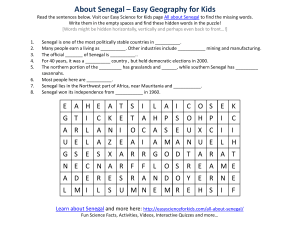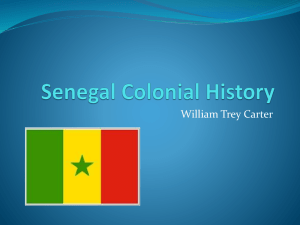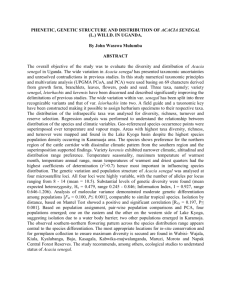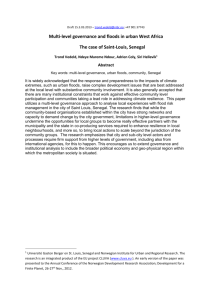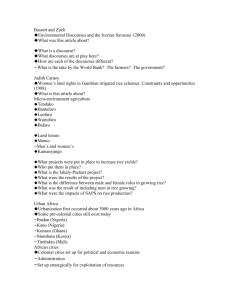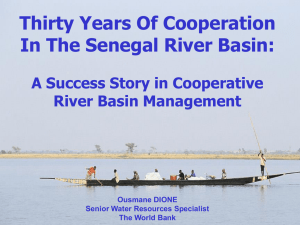DAM REOPERATION SENEGAL RIVER CASE STUDY
advertisement
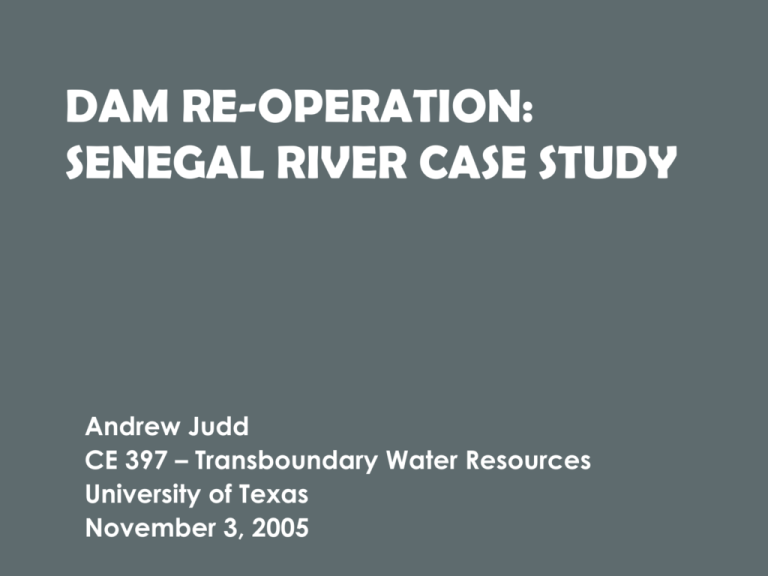
DAM RE-OPERATION: SENEGAL RIVER CASE STUDY Andrew Judd CE 397 – Transboundary Water Resources University of Texas November 3, 2005 Potential Benefits & Costs of Dams Benefits Costs Hydropower Planning & Design Irrigation Construction Urban Water Supply Operation & Maintenance Flood Protection Resettlement Navigation Social Recreation Environmental Health Circumstances for Re-operation •Unforeseen issues and impacts •Change in culture, policy, technology, economy •Mismanagement Issue: Existing Dam operation not at optimal level Resolution: Change existing dam operation system to achieve more optimal (beneficial) or less harmful results Dam Re-operation Process •Re-cognition of deficiency •Re-assessment of benefits and costs •Re-view management procedure •Re-commendation for optimization •Re-vise operation strategy •Re-alization of increased benefits Examples of Re-operation Strategy Outcome Offstream Storage Riparian Habitat Restoration Operation Coordination More Natural Flow Regime Flood Easements Sediment Transport Power Source Shifting Environmental Flows Controlled Flooding Ecosystem Restoration Senegal River: Hydrology Flow supplied by upper basin precip. Upper: ~2000mm/yr Lower: <500mm/yr Wet and Dry Season Wet: April-October High Water: July-October Low Water: Nov-April Bafing Bafing Tributary ~50% of Flow in Senegal River Source: http://www.waterandnature.org/flow/cases/Senegal.pdf Senegal River: Population ~2 million people live in the Senegal Basin ~85% depend on the river for subsistence Agriculture •Farming: Irrigation based and floodplain recession •Fishing: Riverbed, delta, floodplain •Livestock: Mostly nomadic grazing in floodplain pastures Source: http://www.unesco.org/water/wwap/case_studies/senegal_river/senegal_river.pdf All sectors depend on river system (not just water) for production Senegal River: Development 1972-73 major drought in basin 1972 Mauritania, Mali, Senegal convene to form Organisation pour la mise en valeur du fleuve Sénégal (OMVS) Propose economic and resource development through construction of Manantali and Diama Dams Drought in Senegal Source: http://us.oneworld.net/article/view/114123 Diama Dam Finished in 1986 Purpose: Provide barrier to saltwater intrusion, supply for irrigation projects, navigation Source: http://www.omvs.org/fr/realisations/diama.php Source: http://www.unesco.org/water/wwap/case_studies/senegal_river/senegal_river.pdf Manantali Dam Finished in 1988 Purpose: Hydropower Generation, Irrigation Supply, Flood Control, Navigation Source: http://www.omvs.org/fr/realisations/diama.php Source: http://www.unesco.org/water/wwap/case_studies/senegal_river/senegal_river.pdf River as a Resource Variable flow conditions provide a somewhat balanced cycle for different sectors of agriculture and natural ecosystems High Flows Fish spawning, Sediment transport, Soil saturation, Riverine vegetation control Lower Flows Recession agriculture, Animal grazing, Dry Season Species control Changes in the River’s flow regime cause changes in the entire River system Impact of Dams Objective of Dams to increase production, income and quality of life of people of Senegal Dam Benefits Issue Hydropower Production started 2002, 10 years behind Navigation Navigation facilities still incomplete Irrigation Resources lacking to implement, Importing rice cheaper Water Availability Salinity Control Invasive species (birds, plants, bugs) water-borne disease outbreaks Other Issues: •Smaller floods + dams decrease production = less income •Conversion of society from self-sufficient to wage labor based •But, not as dependent on river for production Existing Management Managing Organization: OMVS Management Philosophy (generalized): Equal distribution of benefits and costs of Senegal River development throughout Mali, Senegal, and Mauritania •Cooperative ownership •Water allocation not state-based •Divided amongst several sectors: agriculture, inland fishing, livestock raising, fish farming, tree farming, fauna and flora, hydroelectric energy production, urban and rural drinking water supply, health, industry, navigation, the environment Re-operation Management 1997 Global Environmental Facility (GEF) project –Develop more effective/comprehensive management strategy –Include environmental issues –Increase stakeholder involvement 2002 Senegal River Water Charter –Procedures for water allocation –New water projects –Environmental Protection –Stake-holder Participation Change in management strategy –Mainly facilitated by foreign involvement (NGO’s, World Bank, et al.) –Studies of impacts to population and environment –Communication to OMVS of issues and potential solutions –Funding to implement environmental management projects Re-operation Strategies Controlled Flood •Continuation and improvement of irrigation “transition” flooding •Restoration of floodplain ecosystems –Increase fish population –Improve grazing and farmland –Provide habitat for bird migration –Control invasive species –Improve quality of life of local stakeholders •Recognition of value of natural environment and traditional livelihood practices Source: http://edcintl.cr.usgs.gov/senegalfeature/air.html Lessons Learned •All potential factors and impacts considered in project cost benefit analysis •Local stakeholder involvement required for project to provide benefit to •Greater flexibility needed in management strategies to achieve optimal system Discussion Question: With the implementation of re-operation projects, regulation and management agencies tend to support operation strategies that have very specific definitions of water allocation volumes and water quality levels. However, river systems tend to react more favorably to a more flexible operation strategy. Through what means can these two opposing management strategies be combined to produce more effective water resource re-operation plans?
